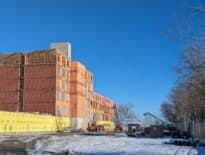
Ed Augustus
For generations, Gateway Cities were gateways not only to Massachusetts but to America. For new arrivals, they offered plenty of jobs and plenty of affordable housing. But more than that, they offered the promise of possibility – the chance to get in on the American dream at the ground level.
Our Gateway Cities have evolved. They are not the same manufacturing hubs they once were. And the costs of rents and homes have risen far higher and faster than the incomes of our talented workforce.
There are plenty of reasons why rents and home prices are so high. But at the center is an age-old economic force at work: Supply and demand. We don’t have enough housing in Massachusetts to meet the demand. And when something is in short supply, prices rise.
Gov. Maura Healey’s housing strategy involves striking right at that root cause by increasing our state’s housing supply.
Gateway Cities should pay close attention. There are several initiatives they can put to good use.
Tax Relief for Housing Construction
The governor last fall signed into law a $1 billion tax relief package that puts money back into the pockets of Massachusetts taxpayers. Included in that law were increases to two valuable programs for producing housing. One is the state’s own Low-Income Housing Tax Credit, which is a vital tool for the production of affordable housing.
The other is the Housing Development Incentive Program. This program is specifically for Gateway Cities and provides tax incentives to developers to either build or rehab buildings for market-rate multi-unit housing.
The governor increased this program’s annual budget from $10 million to $30 million and added a one-time bump of $57 million to kickstart projects.
This is a tremendous tool for office space conversions as well as the rehab of other buildings that have fallen out of use. That makes this more than just a program for increasing housing – it’s a way to reshape our cities to meet the demands of today.
Our Gateway Cities are full of old class B and class C office space – often on the upper floors of critical downtown blocks. Many of these buildings will never come back as office spaces. But they are prime opportunities to revitalize our cities and create 18-hour downtowns by converting them to housing.
Instead of leaving our downtowns at the end of the workday, residents of these new homes return there (or stay if they work from home as many of our workers now do). Structures important to our downtowns are saved, housing is created and nearby businesses benefit from a built-in customer base.
These tax incentives are available to our communities now.
Transit Zoning an Opportunity
Many of our Gateway Cities also fall under the MBTA Communities law. This law is an opportunity for our communities to maximize our housing potential where it makes the most sense to do so – right along our public transportation corridors.
For too long, we’ve designed and zoned our cities around an auto-centric society. The MBTA Communities law requires 177 cities and towns with the most direct access to public transportation to have at least one area in which multifamily housing is permitted. This is not only good housing policy, but good transportation and climate policy, too. As we add housing, we can do so where more people have easy access to trains and buses.
And communities don’t need to figure this out on their own. The Healey-Driscoll administration has provided nearly $6 million to these MBTA towns and ciites in assistance for developing these zoning districts. And last year, the Executive Office of Housing and Livable Communities updated the guidelines after listening to communities. Those updated guidelines now recognize the need to incorporate mixed-used development into these districts – accounting for businesses and retail space on the first floor of multifamily housing.
Communities have the power to shape these districts in a way that makes sense for them. But it is the law and compliance is not optional.
Affordable Homes Act Opens Doors
Taking advantage of these initiatives now, Gateway Cities can pave the way for a new future – one where housing helps drive economic success with housing choices for every budget.
And we need to do more. The Affordable Homes Act, filed by the Healey-Driscoll administration, will authorize $4.12 billion in spending to jumpstart the building of more housing across the state – from our gateways to our backdoors. And more than just a spending bill, it will enact 28 substantive policy changes. Things like accessory dwelling units under 900 square feet by right. This one change could gently add 8,000 to 10,000 apartments across the state in the next five years.
We need to act now to add these additional tools for our communities to use. Passage of this act means more affordable housing for our workers. It means more good jobs. And it means stronger communities with even more economic prosperity. Massachusetts can turn the tide on rising housing costs and our Gateway Cities can lead the way.
Ed Augustus is the secretary for the Massachusetts Executive Office of Housing and Livable Communities and the former city manager of Worcester.






